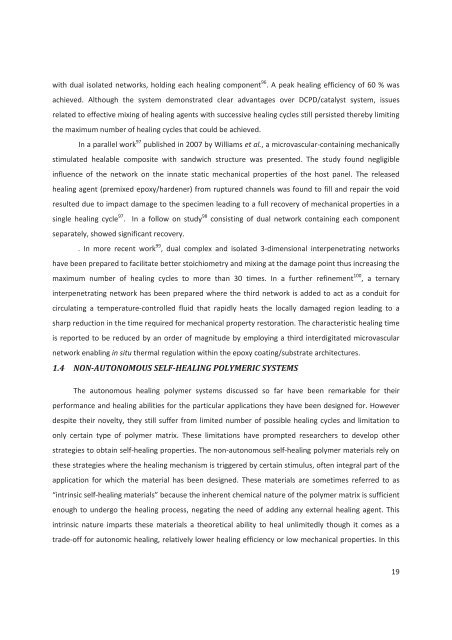4(%3)3 - Ecole nationale supérieure de chimie de Montpellier
4(%3)3 - Ecole nationale supérieure de chimie de Montpellier
4(%3)3 - Ecole nationale supérieure de chimie de Montpellier
You also want an ePaper? Increase the reach of your titles
YUMPU automatically turns print PDFs into web optimized ePapers that Google loves.
with dual isolated networks, holding each healing component 96 . A peak healing efficiency of 60 % wasachieved. Although the system <strong>de</strong>monstrated clear advantages over DCPD/catalyst system, issuesrelated to effective mixing of healing agents with successive healing cycles still persisted thereby limitingthe maximum number of healing cycles that could be achieved.In a parallel work 97 published in 2007 by Williams et al., a microvascular-containing mechanicallystimulated healable composite with sandwich structure was presented. The study found negligibleinfluence of the network on the innate static mechanical properties of the host panel. The releasedhealing agent (premixed epoxy/har<strong>de</strong>ner) from ruptured channels was found to fill and repair the voidresulted due to impact damage to the specimen leading to a full recovery of mechanical properties in asingle healing cycle 97 . In a follow on study 98 consisting of dual network containing each componentseparately, showed significant recovery.. In more recent work 99 , dual complex and isolated 3-dimensional interpenetrating networkshave been prepared to facilitate better stoichiometry and mixing at the damage point thus increasing themaximum number of healing cycles to more than 30 times. In a further refinement 100 , a ternaryinterpenetrating network has been prepared where the third network is ad<strong>de</strong>d to act as a conduit forcirculating a temperature-controlled fluid that rapidly heats the locally damaged region leading to asharp reduction in the time required for mechanical property restoration. The characteristic healing timeis reported to be reduced by an or<strong>de</strong>r of magnitu<strong>de</strong> by employing a third interdigitated microvascularnetwork enabling in situ thermal regulation within the epoxy coating/substrate architectures.1.4 NON-AUTONOMOUS SELF-HEALING POLYMERIC SYSTEMSThe autonomous healing polymer systems discussed so far have been remarkable for theirperformance and healing abilities for the particular applications they have been <strong>de</strong>signed for. However<strong>de</strong>spite their novelty, they still suffer from limited number of possible healing cycles and limitation toonly certain type of polymer matrix. These limitations have prompted researchers to <strong>de</strong>velop otherstrategies to obtain self-healing properties. The non-autonomous self-healing polymer materials rely onthese strategies where the healing mechanism is triggered by certain stimulus, often integral part of theapplication for which the material has been <strong>de</strong>signed. These materials are sometimes referred to as“intrinsic self-healing materials” because the inherent chemical nature of the polymer matrix is sufficientenough to un<strong>de</strong>rgo the healing process, negating the need of adding any external healing agent. Thisintrinsic nature imparts these materials a theoretical ability to heal unlimitedly though it comes as atra<strong>de</strong>-off for autonomic healing, relatively lower healing efficiency or low mechanical properties. In this19











